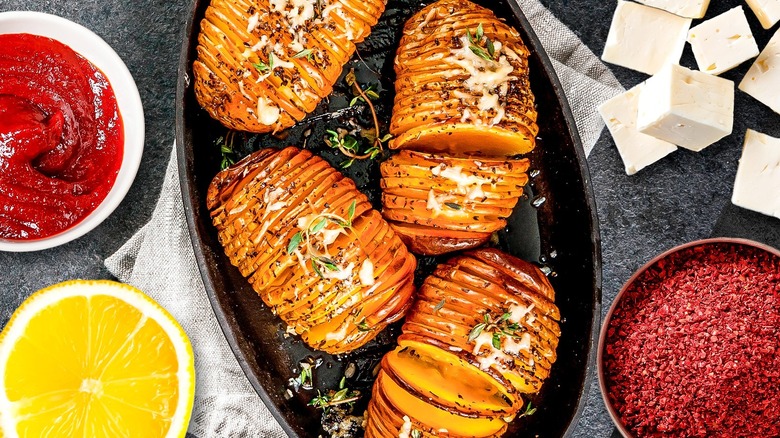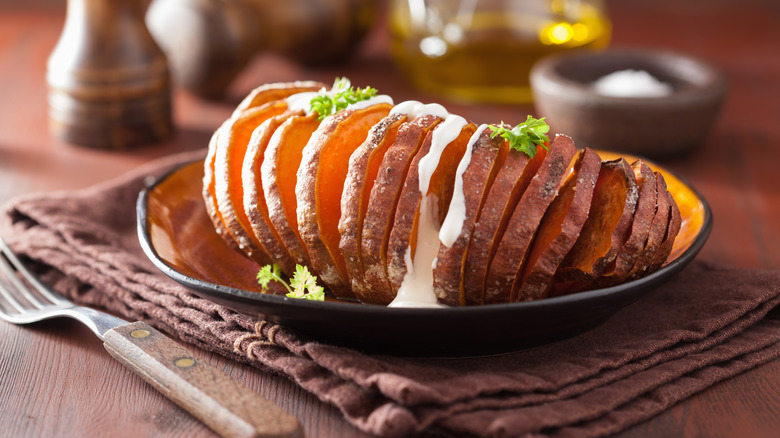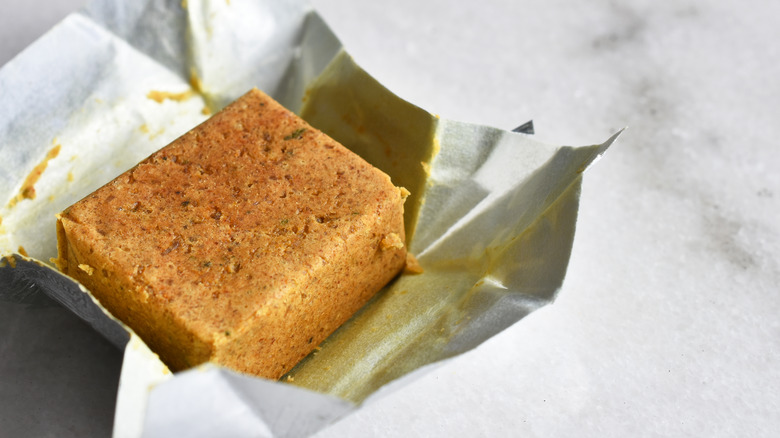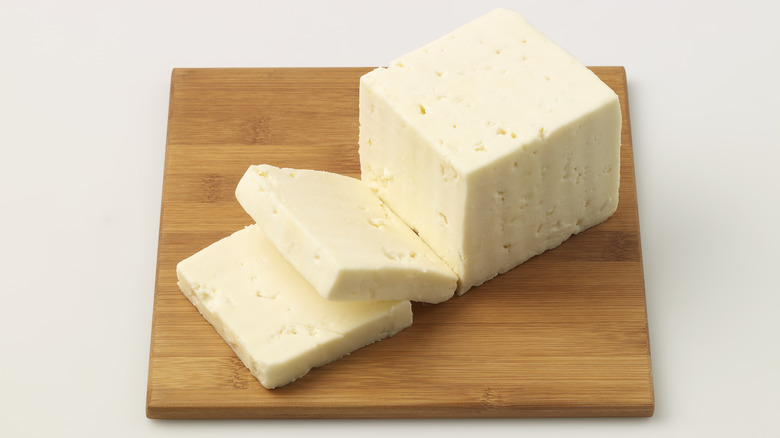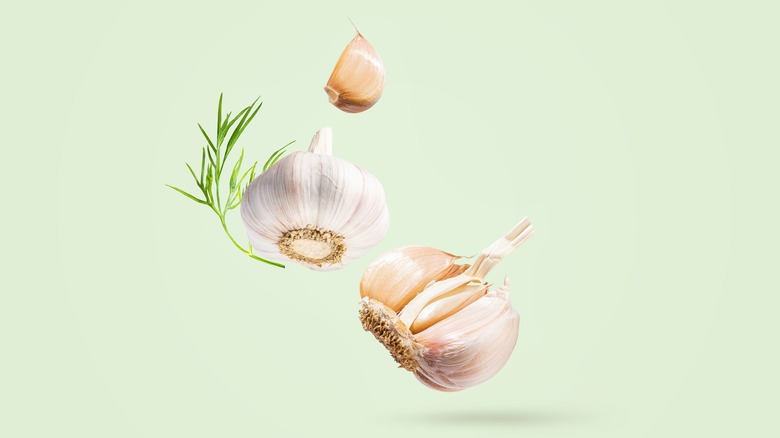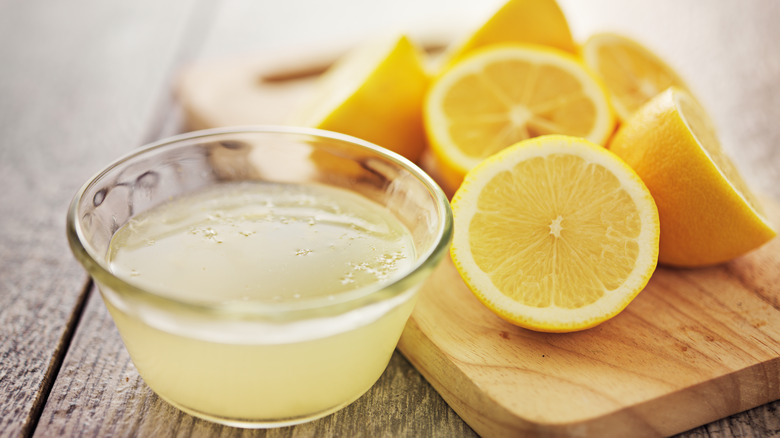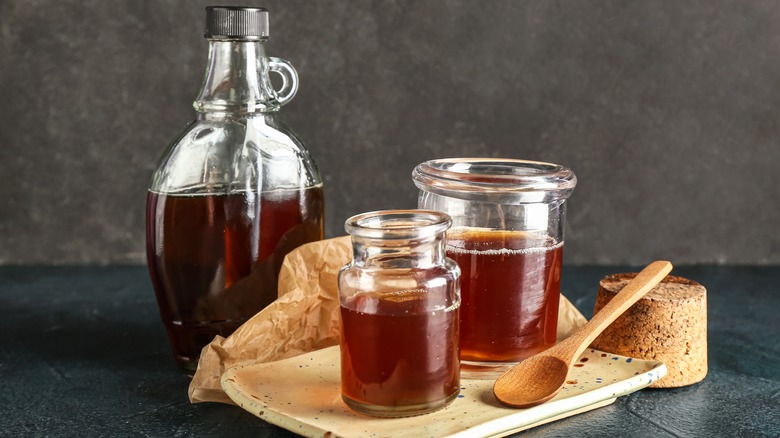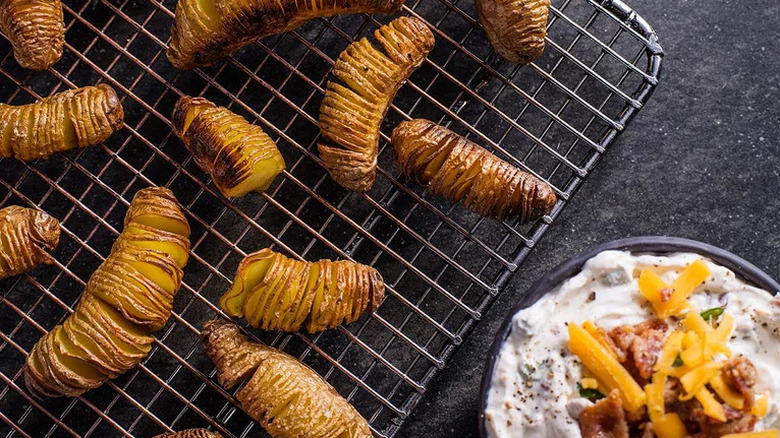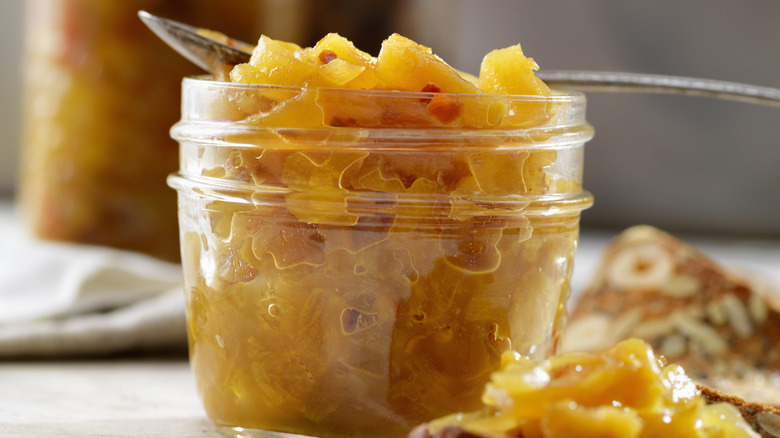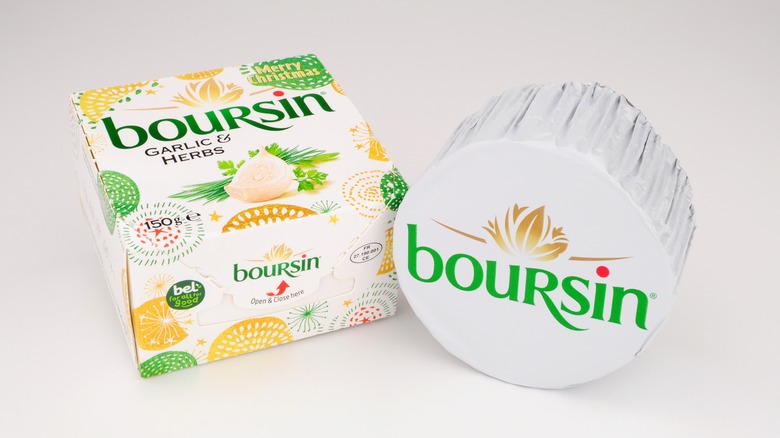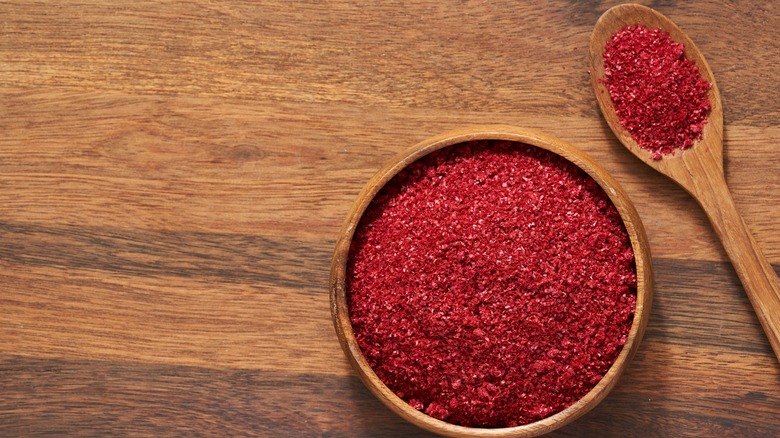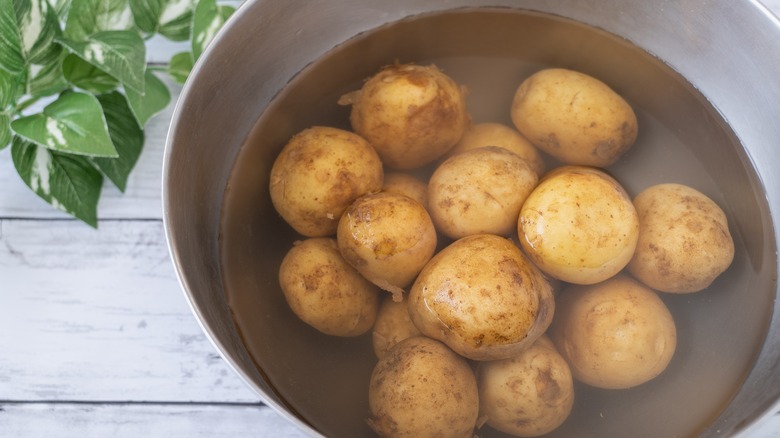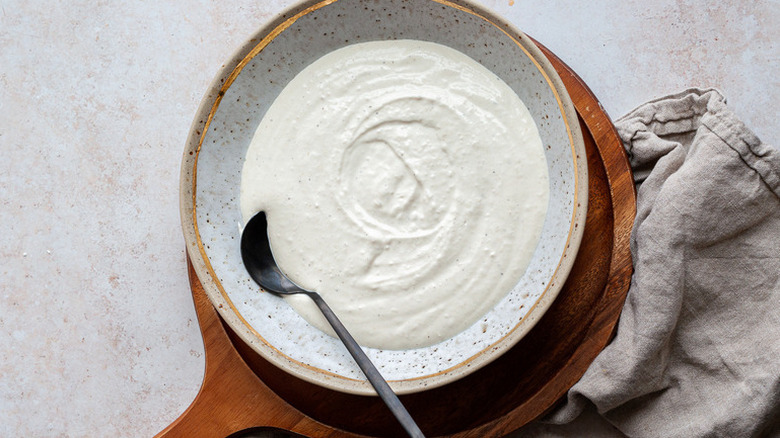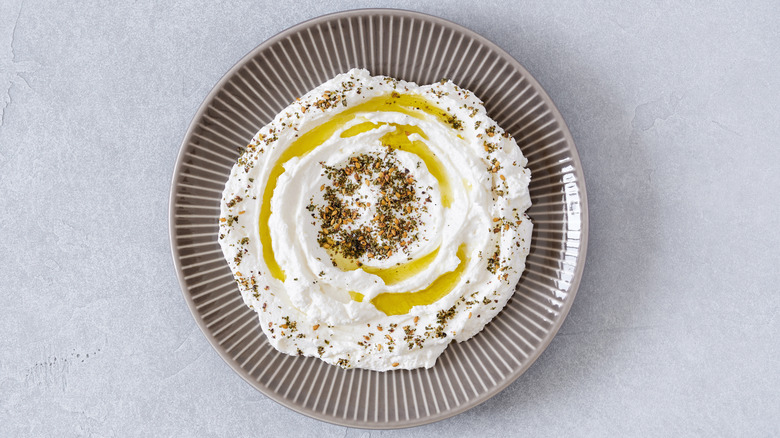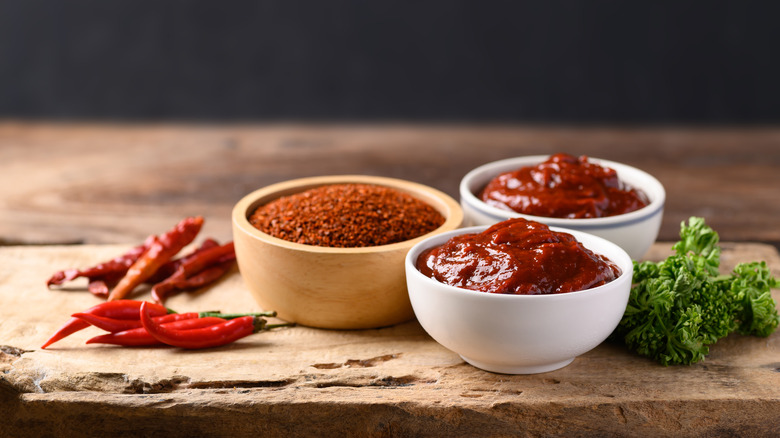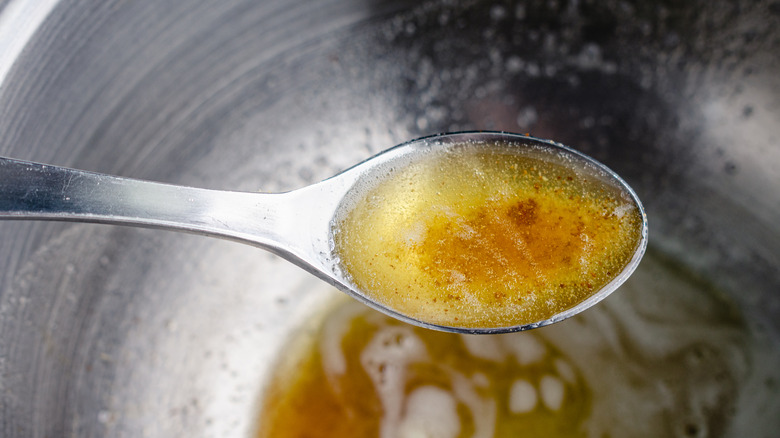15 Ingredients To Elevate Hasselback Potatoes
Potatoes are some of the best shape-shifters in the food world. From crispy french fries to creamy mash, they are one of the most versatile (and wallet-friendly) veggies in the produce section. If you're looking for a crowd-pleasing appetizer or side dish that won't break the bank, you have plenty of options for how to prepare potatoes. You may choose to simply toss some fingerlings in olive oil, salt, and pepper and roast them in the oven, or boil some Yukon gold potatoes and combine them with butter and sour cream for a rich, tangy mash. But if you're looking for a potato recipe that is visually appealing and easy to pull off, Hasselback is the way to go.
Hasselback-style potatoes are thinly sliced width-wise, but only cut about halfway, looking something like an accordion. When they're baked in the oven, the slices get deliciously crispy. While you typically see this method used on potatoes, the Hasselback preparation is for more than just potatoes – you can Hasselback anything from zucchini to eggplant to melons and more. The technique itself is easy to master, especially if you make use of this genius chopstick trick to get perfectly sliced Hasselback potatoes every time.
Once you've sliced them, your spuds can be as simple or extravagant as you like. There's nothing wrong with a Hasselback potato simply rubbed with butter and seasoned. However, if you want to take things up a notch, here are 15 outside-the-box ingredients to consider.
Sweet potatoes
One of the best ways to elevate Hasselback potatoes is to swap out the main ingredient. Sweet potatoes are an ideal candidate because of their similar shape and texture to regular potatoes. However, sweet potatoes' naturally sweet, earthy flavor makes for a completely different experience on the palate. You'll prepare Hasselback sweet potatoes in the same way as normal spuds. Make ½-inch cuts width-wise along the entire potato, placing a chopstick on either side to ensure you're not cutting all the way through. From there, it's all about how you want to season and roast them.
Sweet potatoes pair equally well with sweet and savory ingredients. Make dessert-worthy easy Hasselback sweet potatoes by loading them up with things like butter, maple syrup, honey, mascarpone cheese, chopped nuts, or even marshmallow fluff. Alternatively, dress up Hasselback yams with ingredients like spicy chorizo, garlic-infused olive oil, or a roasted pepper tapenade. Whichever route calls your name, you're bound to end up with a delicious, nutritious, and visually stunning Hasselback sweet potato.
Bouillon
A great way to start brainstorming about how to elevate Hasselback potatoes is to consider ingredients commonly used to give roasted potatoes a flavor boost. One such ingredient is bouillon. Typically found in powdered or cubed form, bouillon is made from dehydrated stock and spices. While it was traditionally kept in the pantry as an easy way to add more flavor to stock, it has many uses in the kitchen today. Its concentrated profile helps level up everything from pan sauces to roasted veggies to pasta dishes, and beyond.
With Hasselback potatoes, the best application is simply to sprinkle bouillon powder (or a crumbled cube) directly on the potatoes with some oil or butter before baking. Be sure to get the powder deeply in between each slice of potato. The powerful, concentrated taste of the bouillon powder infuses the entire Hasselback potato with an otherwise difficult-to-achieve, explosive flavor. Use your preferred bouillon brand and flavor, and feel free to experiment with adding other ingredients on top of the bouillon, like shredded parmesan cheese or herbs. Do a taste test for salt content in the bouillon before adding any other seasoning.
Feta cheese
Feta cheese is a wonderful source of calcium, B vitamins, folate, and more. The briny, tangy, mildly sour cheese, traditionally made with sheep's or goat's milk, originated in Greece. Luckily, you don't have to book a ticket to Santorini to experience feta cheese — it's available at a reasonable price in grocery stores and on menus throughout the United States. Feta may not be the most common ingredient to pair with potatoes, but, this unique cheese can upgrade a variety of potato dishes in some unexpected ways (like these baked feta mashed potatoes, for example).
Feta makes a fantastic upgrade for Hasselback potatoes too, especially when the spuds are dressed with other Greek-inspired flavors. Drizzle some olive oil, lemon juice, parsley, oregano, and salt, the same way we prepare them in our Greek sausage and Hasseback feta potatoes recipe. The sausage makes this recipe a complete meal, but the feta-stuffed potatoes are a lovely side dish all on their own. Feta's sharp taste brings a whole new level of flavor to earthy potatoes — and it would work in Hasselback sweet potatoes, zucchini, eggplant, or squash just as well.
Garlic and herbs
When you want to create a potato dish that looks sophisticated but uses simple flavors, go for classic garlic and herbs. Hasselback potatoes with garlic and herbs make for a no-fuss, mouthwatering dish using accessible ingredients. A simple garlic-herb crispy Hasselback potato recipe requires only a handful of ingredients: Olive oil, garlic cloves, fresh parsley, and salt and pepper. Garlic cloves add a signature, pungent bite to the potatoes, while fresh parsley gives a fresh, herbal vibe to the mix.
That said, you could certainly take the garlic and herb theme and run with it. Other herbs that work well with potatoes and garlic include chives, oregano, thyme, or rosemary. Combine fresh herbs with any dried herbs that catch your eye in the pantry, or, if you don't have fresh herbs on hand, stick with dried herbs or seasoning blends. Sometimes you don't need a bunch of fancy ingredients for a winning potato dish.
Lemon juice
Contrasting acidity and alkalinity in foods is crucial and leads to more nuanced, balanced, and full-flavor meals. Lemon juice has a knack for brightening up whatever it touches, and refreshing, acidic juice balanced with earthy, starchy potatoes is a match made in heaven. Although you could simply squeeze some fresh lemon juice directly onto Hasselback potatoes after baking, incorporating lemon juice beforehand allows for that sour, sunshiney flavor to fully penetrate the tubers.
For example, this Greek lemon potatoes recipe wasn't designed with Hasselback potatoes in mind, but the same process can be applied here. Instead of slicing the spuds into halves or quarters, pour the mixture of lemon juice, chicken broth, olive oil, oregano, and salt over raw potatoes that have been prepared Hasselback-style. Pouring the broth, oil, and lemon juice mixture over the potatoes leads to a softer interior, crispier exterior, and richer flavor throughout the finished product.
Maple syrup
Maple syrup won't be a great pairing with most varieties of white potatoes — it's too sweet and rich — but maple syrup and Hasselback sweet potatoes are a perfect fit. Sweet potatoes and maple syrup offer different profiles of sweetness. Sweet potatoes have a natural, earthy quality to them, while maple syrup is closer to candy in its flavor profile. You can use maple syrup to enhance yams prepared in many ways, but Hasselback sweet potatoes, with their many nooks and crannies, are an ideal vessel for the natural syrup.
Real maple syrup (it's worth the splurge instead of using the fake stuff) caramelizes over the sweet potatoes as they bake, leading to a crispy, candy-like texture fresh out of the oven (not to mention a fabulous scent while they bake). And while maple syrup and sweet potatoes on their own are a delicious treat, you can also dress them up with other ingredients. Try fresh herbs and garlic for a sweet-and-savory combo, marshmallow fluff for a dessert option, butter to pull everything together, or whatever you're in the mood for.
Cheesy bacon dip
There's nothing like a baked potato fully loaded with sour cream, shredded cheddar cheese, bacon, and chives. It's a classic steakhouse side and a great way to turn a humble potato into something resembling a complete meal. The only problem with loaded baked potatoes is that they tend to get a bit messy after the first few bites. If you want equal topping distribution in each bite without the mess, try mini Hasselback potatoes with cheesy bacon dip on the side. You can use fingerlings or other small potatoes for bite-sized, appetizer-friendly noms, but larger potatoes work just as well.
Once the Hasselback potatoes have been baked, serve them with a cheesy sour cream and onion dip loaded with bacon bits. With a base of tangy, smooth sour cream, it's easy enough to dip the Hasselback potatoes directly into the spread, but you could also take the cheesy dip and spoon it into the spuds' crispy crevices after baking. Whichever way you choose to execute, wait to introduce the Hasselback spuds and dip until after baking — the cheese and sour cream mixture won't hold up well in the oven.
Chaat (chutney and spices)
Indian street food is some of the tastiest in the world, and there's a whole category of it that can inspire Hasselback potatoes in delicious ways. The term "chaat" refers to a wide variety of Indian street foods from multiple parts of India. The exact ingredients vary from region to region but typically lead to an explosion of tangy, sweet, tart, smoky, and spicy flavors.
TV host and author Padma Lakshmi took this fun fusion idea and ran with it. In an Instagram video, she shared a street food-inspired take on Hasselback potatoes, serving up the spuds chaat-style with a date and mango chutney; spices like Urfa chiles, smoked paprika, and mango powder; and yogurt and mint. While Lakshmi's recipe calls for a couple of ingredients the average home chef may not have on hand, the spice and chutney combination can go in many different directions — if you're craving it, experiment with what you have in your pantry.
Boursin cheese
What's not to love about a soft, creamy, spreadable, and delicious cheese? Boursin is an herbaceous cow's milk cheese guaranteed to lend boatloads of flavor to potatoes, omelets, soups, charcuterie boards, and more. The brand has been around since 1957 and has grown extremely popular around the world, with multiple flavors and even a dairy-free option. There are myriad ways to combine Boursin with potatoes, but incorporating the rich cheese into Hasselback potatoes just might be the best one.
Every variety of Boursin could theoretically be used to elevate Hasselback potatoes. The garlic and fine herbs flavor is sure to be a crowd-pleaser, but you could also go with the shallot and chive, basil and chive, black pepper, or onion and herbs styles (or combine a few for a real party). Experimenting with Hasselback sweet potatoes? Boursin's fig and balsamic cheese will make a great addition that perfectly balances sweet and savory flavors.
Sumac
Sumac is a flavorful powder derived from dried and ground sumac berries. With a bright, citrusy taste, sumac can be used to punch up any number of ingredients that pair well with citrus. Food Network star Alton Brown swears by sumac as a secret ingredient in starchy dishes, allowing the zesty powder to add a little zing to everything from beans to rice to potatoes.
Since lemon juice is commonly used to spruce up potato dishes, and sumac's citrus-forward profile offers a similar effect, it does make sense here. And it's particularly great for Hasselback spuds. Sumac powder can be sprinkled directly onto the tubers before baking, or you can mix the spice with oil or butter (and additional dried seasonings of your choice) to get an even coating over each potato. Sumac is a great way to take an easy-to-make dish and introduce a less common ingredient that's sure to impress guests.
Brine
Sometimes, the best way to elevate a dish is to approach the main ingredient in a new way. Such is the case with Guy Fieri's crunchy baked potatoes. Few dishes are more basic than baked potatoes, but Fieri isn't cooking up your grandmother's recipe. His version kicks things off by soaking the potatoes in brine for six hours before seasoning them with a simple but effective combination of garlic, salt, and pepper, then popping them in the oven. The result? A baked potato that's ultra-crunchy on the outside and deliciously creamy on the inside, just the way a baked potato should be.
The "Diners, Drive-Ins, and Dives" star applies this method to whole baked potatoes, but it stands to reason that the brining technique would work just as well with Hasselback-style tubers. Brine the taters whole, then slice them up as you normally would, season as you wish, and bake. While you're free to top your spuds however you'd like after baking, honestly, these potatoes don't need much dressing up — this texture stands on its own, even if you're just using butter, salt, and pepper.
Creamy horseradish sauce
Horseradish has a huge flavor punch for an innocent-looking root vegetable. Raw horseradish root also has a pungent scent that hits the nostrils like a ton of bricks and will have your eyes watering in a matter of seconds. Because of its strong taste and smell, horseradish is often mixed with creamy, soothing ingredients like sour cream, Greek yogurt, or mayonnaise, to mellow things out.
Creamy horseradish sauce is a popular accompaniment for beef, but it can also be used as a dip for roasted veggies, on a salad, in creamy soups, and many other dishes. Since potatoes don't have a lot of flavor on their own, this sauce is a great way to elevate any roasted potato dish, including Hasselback potatoes. If you're using this zippy, spicy sauce to dress up your Hasselback spuds, go easy on other seasonings — a little garlic, butter, and herbs will more than suffice.
Parmesan and tahini labneh
Parmesan and potatoes are a hard pair to beat. When combined with roasted, baked, or even mashed potatoes, parmesan's slightly sharp, nutty flavor brings out a satisfying kind of funkiness in the tubers, especially with a garlic and herb situation in the background. Though parmesan potatoes are delightful enough on their own, serving them with a unique dipping sauce is a surefire way to impress your dining companions. Our suggestion is to ramp things up with this parmesan-crusted potato and tahini labneh recipe.
Labneh is made from yogurt that has been strained into a very silky cheese, with a texture falling somewhere between a soft cream cheese and a thick yogurt. Our recipe combines the labneh with nutty tahini, bright lemon juice, zippy garlic, and fresh, grassy dill for a complex dipping sauce. The above-linked recipe calls for whole potatoes, but it's worth the bit of extra time and effort to cut the potatoes Hasselback-style and poke the parmesan cheese in between the slices before baking. The finished product is a rich, cheesy tater that beautifully complements the tahini labneh.
Gochujang
Gochujang is a chile paste made from fermented soybeans, red peppers, glutinous rice, and other spices, leading to a fiery hot sauce, not unlike sriracha in composition. As one of Korea's mother sauces, gochujang is a common ingredient in traditional soups, marinades, and sauces; but really, it can be used anywhere you'd put chile paste to work.
Enter potatoes. Since they have little flavor on their own, gochujang presents the perfect opportunity to give potatoes a killer kick. Hasselback potatoes offer an excellent vessel for gochujang, with their multiple thin slices. Simply mix gochujang with some butter or olive oil and use a pastry brush to spread the mixture over the potatoes before baking — or be bold, and spoon a little chile paste over the potatoes when they come out of the oven. If you're a fan of spicy food, we're willing to bet gochujang Hasselback potatoes will be your new favorite starch.
Brown butter
Brown butter may sound tricky, but it's deceivingly simple to make. All you need is butter, a pan, and a little patience. Once you've mastered the (easy) art of making brown butter, the options for application are endless. Brown butter can add a complex nutty flavor to eggs, amplify cookies and other baked goods, elevate chickpeas, and so much more. It can also help take veggies to the next level, as that's how world-renowned chef Wolfgang Puck upgrades his mashed potatoes, but rich, nutty brown butter is a fantastic way to ramp up potatoes cooked in any style.
Fat is an important ingredient in Hasselback potatoes. The thinly sliced tubers need a layer of fat to get appropriately crispy and to prevent the slices from sticking together. You could use anything from sunflower seed oil to tallow or lard on these bad boys, and classic butter never disappoints, but brown butter? Even better. Whether you use brown butter to coat your potatoes before roasting or spread it over your finished spuds, this complex fat adds deep, toasty richness to Hasselback potatoes.
